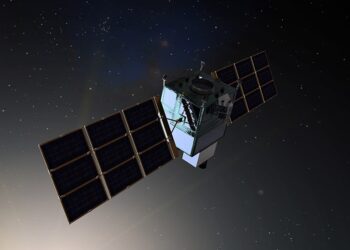Space Force to defend commercial satellites if ordered
SpaceX looks to distinguish Starlink’s commercial from military use
The U.S. Space Force will defend commercial satellites if ordered, according to a policy official with the Department of Defense.
“The Department of Defense (DoD) will defend commercial satellites if ordered to do so,” said John Plumb, assistant secretary of defense for space policy, during a Mitchell Institute webinar last week.
The Mitchell Institute is a think tank focused on aerospace.
Plumb declined to elaborate or deny that a standing order to defend commercial satellites exists.
“I really can’t say more about it,” he said.
The DoD has a policy of defending commercial aircraft and vessels supporting U.S. military operations, said retired Air Force Gen. Kevin Chilton, who hosted the webinar. The DoD has done little to clarify when an attack or interference with a commercial satcom system would trigger a response or what a response would look like.
Commercial satellite services are key to the U.S. military, Plumb said. The Space Force has shifted to a “buy what it can, build what it must” model to leverage commercial products, although DoD officials and legislators continue to urge the military to accelerate its use of commercial components and services.
Thin line between commercial, military satellite services
The U.S. military often has contrasted its own relationship with industry to the situation in China, where officials say government and industry are intertwined. As the Space Force utilizes more commercial services for military uses, adversarial governments might not differentiate between commercial satellites and military targets. Many commercial providers count the U.S. military as a major customer.

One example is SpaceX’s Starlink satellite connectivity. SpaceX founder Elon Musk has insisted Starlink is not for military use, tweeting in September that “Starlink is meant for peaceful use only.” However, the U.S. military is a significant consumer of Starlink services, and SpaceX is one of Space Force’s two, primary, heavy-lift launch providers.
Additionally, Starlink systems have been critical to Ukraine since Russia’s invasion last year. With terrestrial networks knocked out, the Ukrainian government has used Starlink terminals to restore communications. Thousands of Starlink terminals have been donated to the Ukrainian government, with SpaceX providing free connectivity.
Russia has responded, suggesting last year that because Starlink was being used for military purposes, Starlink satellites could be legitimate military targets.
“Starlink is obviously driving them a little bit crazy,” Plumb said.
In December, a Ukrainian official confirmed that the government would be receiving another 10,000 Starlink antennas, but the relationship between SpaceX and Ukraine has not been smooth.
In October, outlets reported that Musk asked the Pentagon to pick up the tab for continued Starlink connectivity for the Ukrainian government. Earlier this month, SpaceX COO Gwynne Shotwell declared that Ukraine had improperly weaponized Starlink and the company could block certain uses of Starlink terminals, according to Bloomberg. Those comments drew backlash from the Ukrainian government, with one of the president’s advisors saying SpaceX should choose sides between Ukraine and Russia.
Starshield designed for governmental use
In December, SpaceX attempted to create a formal distinction between its commercial customers and military customers. The company unveiled Starshield, a national security segment to provide national security launches, hosted payloads and Earth observation satellites.
“While Starlink is designed for consumer and commercial use, Starshield is designed for government use,” the company stated on its website.
Governments that are adversarial to the U.S. may not recognize this distinction because the same satellites that provide Starlink connectivity will be used for Starshield connectivity. Moreover, the DoD continues to refer to Starlink, not Starshield, as it buys SpaceX connectivity services and equipment.









